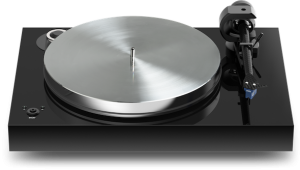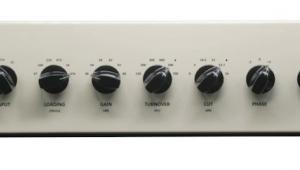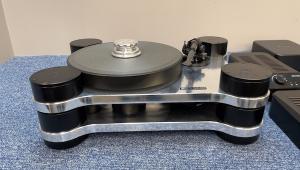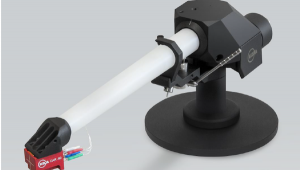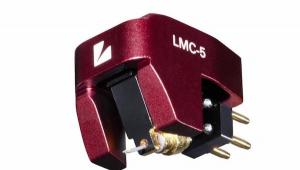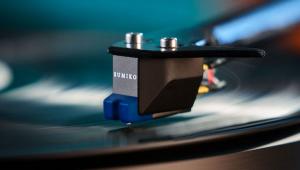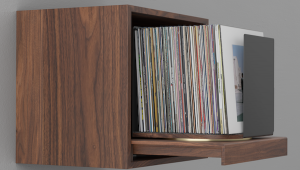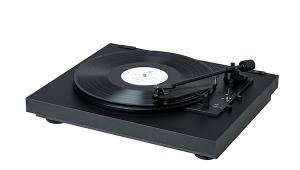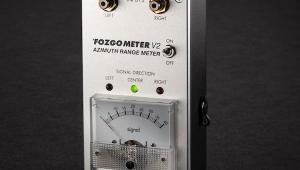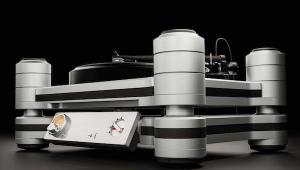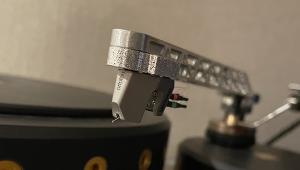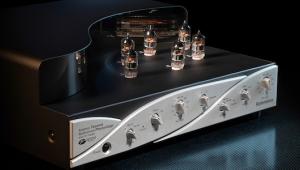This baby is the Song of Solomon 4:1-2 of platter spinning pulchritude.
Brinkmann Taurus Direct-Drive Turntable and Optional RöNt Mk III Vacuum Tube Power Supply
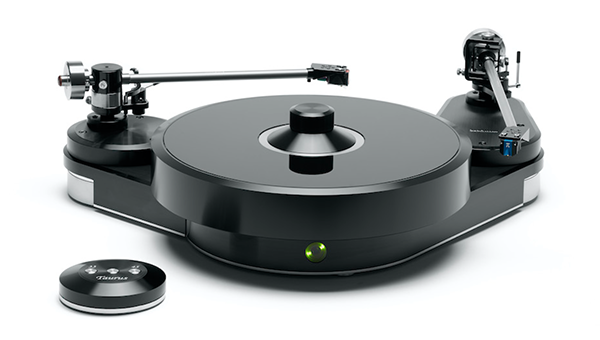
We’ve always loved the level of craftsmanship that goes into the making and performance of all the various turntables and tonearms that emerge from the mind and hands of Helmut Brinkmann, not to mention just how well they’ve consistently performed on the bench and in listening tests. While looking through our archives, we soon enough realized that, while we had indeed reviewed Brinkmann’s 9.6 tonearm and Bardo turntable and had also gotten inside (so to speak) their Spyder and Oasis ’tables respectively, we had never given any virtual ink here on AP to their Taurus turntable, even though it’s been on the market for a while now and has since emerged as one of the German company’s best-selling models.
With all this in mind, we felt it was time to give the Taurus its proper due — as well as discuss Brinkmann’s recently upgraded, optional RöNt vacuum tube power supply, which is now officially designated as having achieved Mk III status. (More on the RöNt III in a moment.)
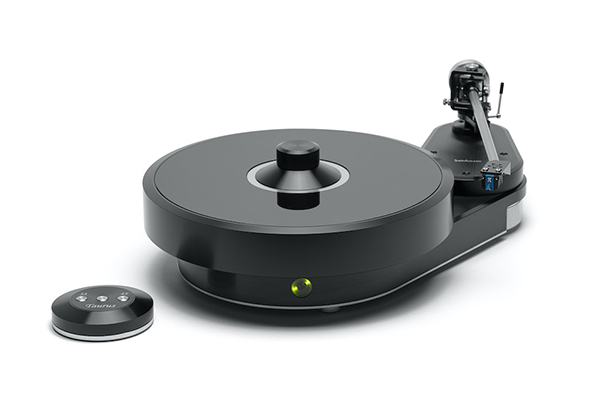
Fact is, “the Taurus accounts for more than 50% of all Brinkmann turntable sales,” according to Anthony Chiarella, the company’s director of U.S. sales and marketing. Like both the Oasis and Bardo ’tables do, the Taurus features the company’s bespoke, magnetic field motor with Soft proportional speed control, as built to Brinkmann’s proprietary design spec. Built on a massive 40mm thick Duraluminum chassis inspired by that of the flagship Balance turntable, the chassis of the direct-drive Taurus is said to be “resonance-optimized,” and it offers wireless speed selection via an engraved aluminum disc that’s intentionally reminiscent of the Balance’s hard-wired control.
The Balance ’table wasn’t the only inspiration for the Taurus, however. According to Brinkmann, the development of the Spyder and its ability to add or remove tonearms with relative ease is said to have prompted Brinkmann to develop a proprietary collar system that enables the Taurus to easily convert from a one-arm to a two-arm system, and vice-versa. Virtually all tonearms from 9 to 12in lengths are accommodated by the Taurus.
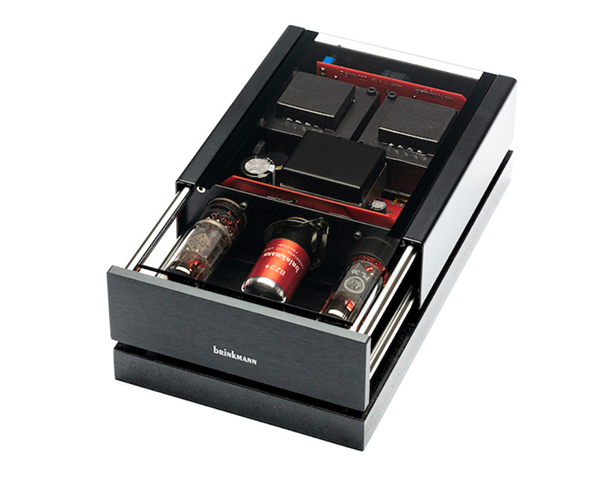
Speaking of the now-current optional RöNt III power supply, Chiarella points out that “one of the highlights of the RöNt III is the new BZ34 rectifier tube simulator, which is a Helmut Brinkmann invention intended to match the sound of a NOS Mullard GZ34 rectifier tube — but with a virtually unlimited lifespan.” The BZ34 is available separately for an SRP of $790, and Chiarella further confirms that it will also work with all earlier RöNt models.
Other Taurus specs and features include a 10kg alloy platter with a planar-polished crystal glass mat; a lubricated precision hydrodynamic journal bearing; RCA, XLR, or feed-through keyway for tonearms with 5-pin DIN connectors; a solid-state power supply; a remote control; and a record clamp. The Taurus weighs 22kg in total — with the chassis being 12kg, and the platter 10kg — and its dimensions are 420 x 100 x 320mm (w/h/d). Optional accessories include a granite base and a custom HRS isolation base.
As for all the related costs, Brinkmann has long offered package pricing for various ’table/arm combos, but let’s start with the baseline SRPs first. The Taurus itself has an SRP of $16,900, while the optional RöNt III runs $6,990 separately. The RöNt III drops to $4,990 when ordered specifically with the Taurus in lieu of the aforementioned supplied solid-state power supply, for a combo SRP of $21,980. A Taurus package with the company’s 10.5 tonearm runs $22,290, while the 12.1 tonearm pack is $22,590. Include the RöNt III in the Taurus ’table/arm combo package mix, and the 10.5 pack ups to $27,280, while the 12.1 pack becomes $27,580. Finally, adding a second Taurus tonearm base with the standard or extended top plate runs an additional $3,490.
For more about Brinkmann, go here.
To find an authorized Brinkmann dealer, go here.
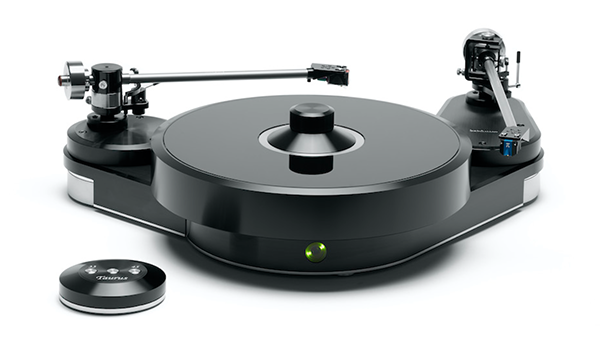
- Log in or register to post comments


I understand that there are things about audio we do not understand, but the need for clean, stable power to a turntable motor is completely understood. If this overpriced tube power supply changes the sound from this table then it is either more or less stable than the stock unit.
There is nothing magical about a tube in a motor power supply. There is nothing that this tube unit can do that solid state power can't do . It is a shameful exploitation of everything that is wrong with this hobby preying on those who do not understand anything about electronics.
"Hey, let's put a tube in it and the fools will pay $5,000 extra !!!!"

Perhaps a touch more vibrato with the tubed supply!
I wonder if they could actually run the table measurements with both power supplies and compare. Likely not, that would be kind of objective.
I don't care which someone says sounds better, both are fine. I'd just like to see someone curious enough to actually measure.
Or, ask the manufacturer what the tubed power supply does that they offer it as an upgrade over the regular power supply.

That 2nd order harmonics make for a more consistent and stable power supply to the 'table. One wouldn't hear the result of the tube in the power supply, but the platter would rotate with smoothness as a result of the power 'signal' being more continuous.
Before you jump to your preconceived notions of what the intent of the designer is, assume that Dr. Brinkmann knows what he is doing vs. it's all snake oil. All of his products are superior performers and the reviews on his products are universally lauded.
Maybe someone can ask him they 'why' of what he did before we jump down his throat with disgust and contempt?

And while I am wrong, the tubes DO provide benefits that another process or technology may not!

https://www.tonepublications.com/analogaholic/the-brinkmann-audio-ront-i...
"While I’m not a geeky measurements guy by any stretch of the imagination, a few more album sides of acoustic music and I could swear that the Bardo’s fantastic pitch accuracy was even better with the new, upgraded supply. Breaking out a test record and Feickert’s iPhone App instantly reveals the minuscule amount of speed variation with the stock supply is even lower with the RoNtII in place."

How long does it take the tube part to warm up when I want to play a record?
What is the tube life?
When does the sound degrade during the tube's life?
Then, we hit Carver Country: Replicating the 'transfer factor' of a desirable device...developing a solid state clone of a tube, sure. "The BZ34 performs the identical function but without the performance drift, aging and eventual failure to which all vacuum tubes are subject."
So, they claim tube performance but with a solid state device. We've never heard that before, and there are great examples of this, right?
Pardon my apparent cynicism. How long before PS Audio comes out with a tubed Power Plant? Wouldn't we all love a tubed AC Power Regenerator?
I smell a market niche wanting a void to fill.
_
We also need interconnects designed for tubed signal source to tubed signal preamp, tube to solid state, solid state to solid state; tube to tube preamp to amp, tube to solid state amp, and solid state to solid state amps. Then speakers wires for tubed amp to speaker or solid state amp to speaker.
And, since we are audiophiles, speaker wires for tubed source to tube preamp to tube amp to speaker, plus all the variables. The interconnect and cable market seem not to be keeping pace with the possibilities to optimize our sound.
I am constantly surprised to see where curiosity ends.
Now, if you will pardon me, I've got to go pack my fire starting kit for a camping trip: I use an Audio Technica cartridge that I drag across a record to generate heat.

Stanton 681EEE to warm up the dog's refrigerated food. Works great!

You get it. LOL on the AT cartridge for warmth idea...
But the tubes are made for ultra-long life and he does address the process of tube care approach in those papers. Tubes aren't perfect and if does solve one engineering principal it tries to approach, great! Again, I'm sure there are return policies with a dealer to assist those Brinkmann owners taking a chance on the RONT.
Just glad I got people to read a bit more into it, vs. just crapping down it's neck for the sake of ignoring others' input to learn more (not you, Anton, ever.)

,,,,

What if it's tube to SS, or SS to tube...they need to make more types.
This gets complicated, fast.

Hi
"What is the tube life?" qtd Anton D
Good question !!
"Virtually UNLIMITED lifespan" means how many years the $790 BZ34 tube work to its designed specs ??? The filament which heats up any tube dies sooner if not later - this is physics !!!
Smart readers should be able to differentiate physical fact from some $790 sales pitch !!
JACK L

....with the possibilities to optimize our sound." qtd Anton D
My design/built 99.99+% pure silver interconnects fit all, IMO !
For my audio rig, 7 pairs of such pure silver cables are used to hookup my 2 turntables (one MC to solidstate headamp, one MM), 24bit192KHz DAC, tube phono-preamps, tube power amps, tape deck. Same purity silver power cord for my tube power amps.
They all sound ELEGANTLY musical ! I am so gratifying !!
Listening to silver is believing
JACK L

"And while I am wrong, the tubes DO provide benefits that another process or technology may not!"
and you know this because he states it on his web site? Do you really understand what he is saying or figure if he wrote so much about it then it must be true?
His explanation reeks of audiophile gibberish designed to impress those who don't understand electronics.
It is a simple matter for a competent EE to design a clean, stable power supply for a motor that does not involve vacuum tubes. Despite his claims, tubes do not isolate the load from the source. Full stop. End of story.

He has more than one power supply! You've seen the website.
What's more he has the courage to try and experiment with other power supplies to see what the heck it can do to a sine wave fed to his motor. The 2nd harmonic acts as a sustain for the 1st harmonic, hence a smoother response from the motor.
It's physical science implementation, not electrical engineering at play. You miss the entire proposition of his design. And yet you still disparage my claim BEFORE I even went to the website in the first place. I am open to the concept
You closed the book on the story before you had an open mind to read it. Par for the course on AP and SP sites.

After Brinkmann touted the superiority of the tube rectifier they could hardly back down and offer mere semiconductors. So they emulated the tube with semiconductors and installed it in a glass envelope, perfect, everyone is happy. Me, I'd wait for the ASR or somesuch objective review before handing over hard earned cash.

He has a clear agenda. His so called reviews are designed to prove what he has concluded before he begins. If his test equipment doesn't show any clear difference between 2 items or if he deems that difference to be inaudible (how does he determine that?) , then he declares that they sound the same even though he doesn't listen to them. He is up front that he doesn't trust his own ears. That tells me all I need to know.
Yes, measurements can weed out the bad, but at some point you have to listen.

And did you listen to the Brinkmann with the tubed power supply? No.
This contradiction really nullifies your commentary above. Stating essentially listening is everything and then pulling apart Brinkmann's technology approach is just silly when other reviewers state they hear the difference, much the way you would if you listened to it for yourself.
While I completely agree about ASR, the criticism you level against Brinkmann's approach is not backed by engineering nor is it implied by your statement above. A tubed power supply can act to smooth out 60 hz sinewave variations, much like a digital filter can smooth out a brick wall stairstep. That is valid to an AC-driven, on-off, power supply, direct drive or belt drive.
Lastly, if other professional, long-time reviewers have heard it and speak to the very positive elements to it, that's far more valid than your disparaging comments to the contrary with little to back it. Brinkmann's experience in engineering far outweighs yours, no offense.

I said if it did it was because it was more or less stable than the non tube unit, and if because it is more stable that any increase in stability can be achieved with a SS unit, the improvement is not because it has a tube....
The end

Hi
Surely they all sound different.
The question is: Does the sonic difference perceived by our ears justify the extra 5 grands to get the tube power supply ????
I won't even though I am a vinyl+tube amp addict !!
Be tube smart !
JACK L

When the approach is to add 2nd order harmonics to smooth a sine wave, how could or would ASR ever even KNOW what to look for? One is willfully adding distortion for counter-intuitive reasons to improve something that was created by thinking out of the box.
ASR could never, in a million years, ever think OUT of the box. It is utterly opposed to their existence to test only what they know and draw half-assed conclusions based on what they already know.

In this table, the power supply is not part of the signal change. All it can do is affect speed issues. So, how do second order harmonics figure in? Aren't we extrapolating from a pleasing sonic distortion in matters of signal propagation?
Like I said, I believe people's ears, but I can't quite get the second order harmonic thing into my small caveman brain for speed control.
I still love the vibe of this table, however!
I'd like one!

From what I gather, Brinkman is actually using the longer, smoother waveform of the added 2nd order harmonics (ie distortion) to remove the start-stop function that causes essentially jitter. This is isn't something we would hear per se, but notice in less jittery speed variations by way of the 2nd order harmonics extending the initial 'signal' juuuust a bit longer to smooth out it's performance.

We don't hear it but we "notice" it ??? How so?
What is a "start-stop function" with a motor that spins continuously once you get it going? So you think adding harmonics to the waveform will make the motor run more smoothly and remove "jittery speed variations"? What is "extending the initial signal" ??? How do you come up with this stuff?
Sorry, your whole statement is once again more pseudoscience gibberish.
I gotta stop, your attempt to justify this tube supply is entertaining, but gibberish none the less

Right above. It makes an audible difference to trusted reviewer doing it for years. I never said you wouldn't notice it- you did.
You're assuming that only a linear power supply with increasing accuracy can smooth out AC or DC line ripple. I disagree as stated above about tubes being able do the same thing in a different way- to a mechanical implementation like a drive motor.
Everything is gibberish to a one with a closed mind.
Period.

"You're assuming that only a linear power supply with increasing accuracy can smooth out AC or DC line ripple "
Curious why you feel the need to make things up in an effort to support your gibberish?

Can't be as accurate as a SS or linear power supply.
For this application of TT power supply, it can be and more effective.
All you've claimed is everyone else is full of it- you haven' made any other points about the how of anything.
Increased electron flow by way of the second order harmonic does mean more continous and smoother flow of direct current in the TT power supply.
But it's just more 'gibberish' to you, huh?

What are your credentials other than that of just another trolling nay-saying negative skeptic of something you can't own?

Hi
Not "everyone is happy" to pay extra $5,000 ++ to replace its original SS rotor power supply !!!
Would you be "happy" to pay 5 grands to it ??
JACK L

Everyone that bought into Brinkmann's original explanation is happy!
The problem with the explanation is, it smacks of the endless turntable (& cable) tweaks that were touted in the 70s & 80s, where a change was not necessarily an improvement. It makes people highly sceptical & that is how it should be at this level of investment.

This is actually not the most expensive power supply upgrade I know. For one pretty popular TT brand to upgrade to their top TT power supply you'll have to shell out (according to manufacturer site) 22,000 pounds, more than this (and other manufacturer!) turntable themselves! And man, it is bigger then most power amplifiers.
Will it make the difference?
Measurements of turntables are notoriously unreliable, as "test" records are error-prone and devices to measure vibrations pn such small scale probably not available outside of specialized lab. And of course human ear is even less reliable.
I upgraded DC PS on my turntable (a little less ambitious) from switching power supply to linear, made by third party specifically for my TT. Of course it was SS and much cheaper then $5K. It shouldn't make it sound better, I cannot think of solid theory why it should. Controller with quartz oscillator then transforms this DC to AC anyway )).And yet I think it did )).

I upgraded DC PS on my turntable (a little less ambitious) from switching power supply to linear, made by third party specifically for my TT. Of course it was SS and much cheaper then $5K. It shouldn't make it sound better, I cannot think of solid theory why it should.
a few possibilities
1. It is a given that no motor is 100% stable. There are various forces trying to slow the platter down and these forces vary so there will be some speed variation. The question is at what point does it become audible. The platter speed may be more stable with the linear supply.
2. The linear supply may be generating some noise that gets back into your system's electronics
3. you are imagining things... we all do

I meant to say that the switching power supply may be noisy

That this tubed power supply is less stable or or not linear.
The platter forces aren't even the culprit but the AC line variation and from the transformer, whether AC or DC. It's also not noise feedback. It's the AC or DC signal itself.
DC would be more linear, but even then it also fluctuates. If Brinkmann found a way to smooth the motor out by using tubes I trust him, especially when he has a linear solid-state power supply and this tubed one- and considers it an improvement. He has done the work, not you.
You've speculated on theory, but you haven't heard it either. You're guessing.
The End. lol.

Tests it, we will know.
The measurements will back up its superiority.
"Breaking out a test record and Feickert’s iPhone App instantly reveals the minuscule amount of speed variation with the stock supply is even lower with the RoNtII in place." Tone Audio

anybody relying on a test record and an iPhone app to measure the stability of a turntable needs to turn in their reviewer badge.
and just to be clear... I never said the upgraded supply wasn't better... I never said it wouldn't sound better... I never said much of anything you keep saying that I said..
I said if it was better it was not because it used tubes, I said you didn't need to use tubes to do whatever it does.
so once and for all,,,,, stop embarrassing yourself by arguing against things I never, ever said,,, stop making crap up

Experience than you as well as more scientific method as well. Where's your proof here?

I never said the tube supply was less stable or not linear. I never assumed that
You are delusional

What did you say then? They're both equal?? Right.
Or Brinkman, whose products have massuve ownership and industry, are bullshit?
What the heck are you saying?

here we go again with you making up more things that I never said..
I said
"If this overpriced tube power supply changes the sound from this table then it is either more or less stable than the stock unit.
There is nothing magical about a tube in a motor power supply. There is nothing that this tube unit can do that solid state power can't do . "
That's it, then you went nuts making stuff up and attributing it to me.... and you continue to do so
I'm really tired of saying " I never said that" so I'm done with responding to your fantasies
good day

Perhaps you meant "generating less noise" with 2. It is a possibility.
3. is probably the more probable.. anyway, I do not mind. I spent just 10% of this tube PS, and in a worst case I consider it a proper sacrifice to audiophile gods.

Someone might get hurt. Perhaps we can all agree:
1 - that's a nifty looking turntable
2 - we haven't heard it yet so hey, anything's possible
3 - they've made good products in the past so this one probably doesn't suck
4 - if you think tubes in a power supply can't influence the sound quality of the product please feel free to junk your amp's 5AR4* and stick in a solid state rectifier. I'm sure it'll be fine.
5 - did I mention it looks nice?
* - if you've got one

all your points are valid except 4....
a power supply used in an audio amplifier where it must deliver stable power over a wide frequency range is a very different application than a motor controller that is designed to deliver a single frequency.
In an audio amplifier it is an integral part of the amplifier circuit. You can make a strong argument that it is the most important part. In an audio amplifier it has a direct influence on the signal. In a motor controller it is just trying to keep the motor stable.
2 different things no matter how nice it looks

Tell us precisely how a power supply for a wide range of frequencies should differ from the focus of one frequency.
You make claim but you have no explanation for it. Pure bs and gibberish. You completely backed 100% of my claims previously with your "In a motor controller it is just trying to keep the motor stable" 'almost' sentence. Pure backpedaling and position changing so you don't appear wrong.
The tubes or transistors in an audio signal have the most important role to play in any audio circuit. Get real, dude. They voice the product.

Just because I didn't take the time to go into a detailed explanation does not make it BS or gibberish. For someone with a modicum of electronics knowledge it is really rather simple so I didn't realize I needed to go into such detail. . You should strive to obtain this modicum so you can discuss things intelligently rather than just lashing out at everything I say.
A power supply for an audio amplifier is required to deliver stable power over a wide range of frequencies. Traditionally stated as 20-20KHz, which is about 10 octaves, but in reality should operate beyond those limits. Since the amplifier load (a speaker) does not have a constant impedance (it varies as the frequency varies) the demands placed on an audio amplifier are different than the demands on an AC motor controller, which is only required to provide stable power at a single frequency. . The voltage from an ideal audio amplifier power supply will not vary with frequency which means it has zero output impedance over the full range of frequencies. In practice this is not so easy to obtain. Actually, it is impossible
On the other hand, the motor controller only has to be stable at a single frequency. In fact, it can be tuned to and limited to that single frequency to insure that the motor only sees that single, desired frequency. Everything about it can be optimized to deliver that single frequency. The demands are different because it operates into a load which obviously does not have an impedance that is varying with frequency since the frequency is constant. The Brinkmann motor controller can be optimized for a single known load (the motor used in the Brinkmann table) while an audio amplifier has to work for a wide variety of speakers.
So that is "precisely how a power supply for a wide range of frequencies should differ from the focus of one frequency."
this is kinda like shooting fish in a barrel

Perhaps electrons have changed since I was in the business, but I don't recall a power supply needing to "provide stable power over a wide range of frequencies". The only frequency involved is 0Hz. A power supply typically consists of a transformer to step the voltage(s) up or down, rectification to block the flow of current in one direction and capacitors to smooth out the DC signal. Chokes, voltage regulators and suchlike are often present but not essential to this basic task. The resulting DC supply provides the power for the transistors, tubes, chips, whatever to do their work.
---
I'm grateful for the partial validation (I'm only human) but I still contend that in the absence of an actual audition, we might want to give the designer the benefit of the doubt for now.

An ideal power supply maintains a constant DC voltage no matter what current is being drawn from it. These currents are not constant, they vary with the signal being amplified so they are not 0 Hz.
and I agree about the benefit of the doubt, I never commented on which of the Brinkmann supplies sounds better since I obviously have no idea. My only comment was it doesn't take a tube to make a good power supply for a motor , and then it got waaaaay out of hand with all sorts of accusations and assumptions.

I do not know the answer, or even if it is a worthwhile question...
Many direct drive units can exhibit 'cogging.'
Would, perhaps, the way the tubed power supply somehow, as Glotz said, 'smooth out' the electronic performance of the power supply to the motor and somehow decrease something like cogging?
Apologies for the sub-informed question. Just trying to think if there were any way this difference might be real.

that an increase in current flow means an increase in frequency? That's a new one on me. I always thought that direct current meant 0Hz. If my amplifier has, say +1VDC or -1VDC present at the output terminals, my woofer will move forward or backward and then stay put (assuming an otherwise quiescent input). An increase in voltage or in current flow (remember, a volt times an amp is a watt) will push the woofer farther in the same direction, but not cause it to oscillate. Pump up the volume and you'll lock your voice coil. Ask me how I know. Sorry for the long missive here, but one of our correspondents either a) is demonstrating a poor understanding of the subject at hand or b) expressing himself in confusing terms. Inquiring minds want to know which!
---
With respect to Anton's question: I don't know the answer but I do know that a lot of AC synchronous motors will 'settle down' at a certain voltage. hold an old Papst motor in your hand and bring it down from 115(ish)VAC to 100 on a variac and you will notice a considerable reduction in vibration. I think it's safe to say that a smooth-running motor will exhibit greater speed stability than a shaky one. And of course eliminating those vibrations means they won't be fed into the platter/arm/cartridge/suspension bits. For quite a while I used a home brew device (built by a friend, not by me) with a step down transformer and parallel capacitance hooked to an old LP12 (with no Valhalla board). Yes, you could hear the difference.

No
most people think of DC as an unchanging voltage (O Hz) like a battery , but it actually means current flow in one direction, that the polarity of the voltage does not change. There can be pulsating DC like you get from a rectifier which changes AC (voltage swings + and -) to a voltage that just swings positive, or just negative.
https://en.wikipedia.org/wiki/Pulsed_DC
But I don't think that is really what is causing the confusion. The confusion is the idea that a voltage source can have a constant voltage while supply a varying amount of current. In terms of voltage you do have 0Hz, but in terms of current there is a frequency.
say an amplifier puts out an 8V RMS, 1000 Hz sine wave to an 8 Ω speaker. This translates to voltage peaks of about ± 11V so the current goes from 0 to +1.4A back to 0 then -1.4A and back to 0 and so forth. 1000 times a second. This energy, this current is coming from the DC power supply. Voltage rail constant DC 0Hz, , current flow is 1000 Hz
That's why I said a an amplifier power supply has to supply stable power over a wide range of frequencies. Not that it is creating these frequencies, that it has to supply current and therefore power over a wide range of frequencies.

and if current varies, then one can control it with additives assisting or a linear approach. Either work, and for a 60Hz signal, it would certainly help by adding some fake/additive smoothing like 2nd Harmonic distortion.

...

You have done nothing here but fire off insults and claims that everyone's ridiculous except for you. You're the minority here. And you keep trolling my responses like a child too. You haven't made one sensical statement as to why or why not this PS would work as intended. But you know more than Brinkman. When's your turntable coming out? LOL...


